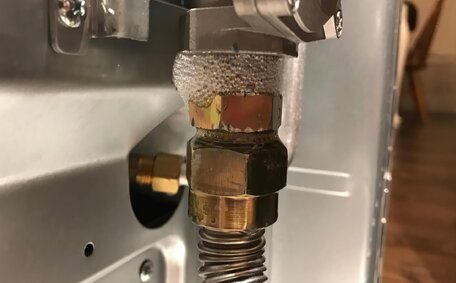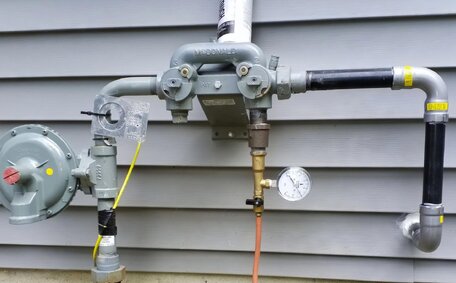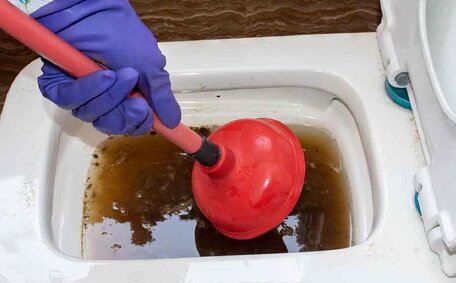Introduction to Pipe Materials and Emergency Preparedness
Selecting the right pipe material is crucial to ensure plumbing systems can withstand emergency situations like freezing temperatures. Efficient plumbing maintains water supply and ensures environmental health safety, so different pipe materials impact outcomes for emergency responders.
This guide analyses how various plumbing pipe materials fare in emergency situations. It details material selection, installation and maintenance best practices, and preventative strategies to handle plumbing emergencies. Continue reading for essential strategies in preparing your plumbing system for hazardous conditions.
Common Plumbing Pipe Types and Their Properties
There are several common types of plumbing pipes used in systems, each with their own properties and applications.
Copper Pipes
Copper, a durably superior option due to its corrosion resistance and installation ease, is widely used for various plumbing applications.
Copper pipe withstands high water pressure, resists external corrosion, scale buildup, and has antimicrobial properties.
PEX Pipes
Cross-linked polyethylene (PEX) pipes are flexible plastic tubing readily available as a durable supply line option. PEX pipe, known for its corrosion resistance, excels in freezing conditions, reducing risks of scaling and ice blockages. Although PEX pipes’ resistance to UV degradation has improved, they have lower pressure ratings compared to copper.
PEX pipes are favoured by many plumbers for their straightforward installation process. Use oxygen barrier PEX rather than non-barrier versions for both hot cold water applications.
PVC Pipes
PVC pipes do not corrode yet have lower pressure ratings relative to metal pipes. Unlike stainless steel fittings, glue must be used for PVC CPVC pipe connections.
PVC pipes better withstand chemicals such as those found in swimming pool water and natural gas than other plastics, yet they may become brittle with age. PVC pipes are economical, durable and widely used in construction, suitable for both hot and cold water systems.
Cast Iron Pipes
Cast iron pipes are more than just long-lasting; they present less of a fire hazard being heavy and difficult to install in other areas. They resist corrosion and can maintain structural integrity with high water pressure, reducing potential fire explosion risks, but the material is prone to buildup and rust. Cast iron is best suited for sewage and too rigid for complex plumbing layouts.
Copper
Copper, due to its superior properties, ranks as a top choice for residential and commercial water supply pipes. It is valued for its durability, corrosion resistance, and antimicrobial properties. However, copper pipes are susceptible to bursting if water inside freezes and expands.
Copper pipes situated in uninsulated exterior walls or attics are susceptible to freezing in winter, particularly in cold climates. Prolonged freezing causes water inside the pipes to expand, leading to bursts and cracks. This destroys the piping and causes major water damage if not addressed quickly.
Despite this weakness in extreme cold, copper piping remains a preferred material in many regions. Its strength, longevity, and resistance to scale buildup offset the bursting risk. Proper insulation and maintenance largely prevent freezing issues with copper pipes.
PVC
PVC, among other materials, is a popular plastic piping due to its low cost and durability. It is resistant to corrosion, abrasion, and chemicals, making PVC an ideal choice for plumbing applications involving saltwater, acids, bases, and chlorinated water.
A crucial advantage of PVC pipes is their ability to withstand freezing temperatures, thus preventing bursts common in metal pipes. The thermoplastic material is more flexible and can expand slightly as water freezes inside. It’s particularly advantageous for water supply in areas shielded from UV light, especially in regions experiencing high temperatures and severe winter conditions.
On the downside, PVC piping becomes more brittle and prone to cracks as it ages. Proper support can used to prevent sagging, which can result in damage to PVC pipes. Overall, PVC strikes a cost-effective balance between durability and freeze resistance.
However, with a lower pressure rating than materials like copper, PVC’s use is restricted to low and medium pressure systems.
PEX
PEX, or cross-linked polyethylene, is a flexible plastic piping material that has gained popularity for water supply plumbing. Key benefits of PEX are its flexibility, durability, and freeze resistance.
The flexibility of PEX allows it to accommodate water expansion and contraction during freeze-thaw cycles. This prevents burst pipes that can happen with rigid copper and PVC systems. PEX is particularly well-suited for areas that experience significant temperature changes.
In addition, PEX does not corrode or scale easily, and although more expensive, the plastic pipe material is more impact resistant than metal alternatives. PEX’s smaller diameter relative to its pressure rating allows for installations in tighter spaces compared to copper.
Potential downsides include reduced UV resistance and lower pressure ratings than copper. Proper installation, which must right the first time, particularly ensuring crimp fittings are secure, is key as incorrectly connected PEX fittings can result in pinhole leaks over time. Overall, PEX strikes a good balance between freeze protection and the long run of longevity.
Susceptibility of Pipe Materials to Freezing
When it comes to freezing temperatures, not all pipe materials react the same. Understanding how different types of pipes respond to extreme cold can help you make an informed decision and avoid expensive plumbing emergencies.
Most Susceptible to Freezing
While copper is resilient against temperature shifts, it features a significant expansion rate under freezing, heightening the risk of bursts. This risk increases in under-insulated pipes exposed to freezing air, especially when it comes to older systems where lead can be a concern.
PVC pipes are also at risk of freezing damage, but to a lesser extent than copper. The plastic material is more flexible and can withstand moderate expansion from ice formation before becoming compromised. Still, extended freezing can cause PVC to crack over time.
Most Resistant to Freezing
PEX piping is the most freeze-resistant option. The flexible tubing can expand up to 3 times its size, allowing PEX to withstand freezing expansion without bursting. PEX is suitable for extreme cold climates, although it can still be damaged from prolonged exposure to freezing.
Galvanized pipes, often more flexible than copper, can tolerate some water expansion when frozen. Insulated carbon steel piping can most likely handle freezing better than copper and PVC. However, uninsulated galvanized steel pipes are still at risk of freezing.
Insulating all exposed pipes, including PVC and PEX, is essential for freeze protection, a recommended practice in the United States. Maintaining adequate heat within your premises can help safeguard your home during cold spells. But selecting freeze-resistant material like PEX can offer enhanced protection.
Preventing and Preparing for Frozen Pipes
There are several key steps you can take to prevent and prepare for potential frozen pipe emergencies:
Insulating exposed water pipes is crucial to protect against freezing. Use foam, fibreglass, or rubber insulating sleeves designed for plumbing. Prioritise insulating pipes in unheated areas like attics, crawl spaces, garages, and exterior walls to guard against pipe freezing.
Sealing Air Leaks
Seal cracks and openings throughout your home to prevent freezing air from reaching pipes. Use caulk, spray foam, or weatherstripping as protective equipment to plug draughty areas, especially around windows and doors.
When temperatures dip below freezing for extended periods, consider shutting off your water supply and draining your plumbing system.
Ensure all taps are open to drain any remaining water from the system.
Maintaining Heat
Use your thermostat set above 55F even when away to help prevent freezing. Let taps drip during extreme cold to maintain a steady water flow within your facility’s pipes. Take extra precautions when going on vacation by maintaining proper heat.
Taking preventative measures can save you from costly repairs and ensure a timely emergency response to water damage. Prepare your plumbing for winter and freezing temperatures by following these insulation, sealing, draining, and heating tips.
Insulating Pipes
Insulating your pipes properly is crucial to prevent freezing and burst pipes during winter. Start by identifying pipes most vulnerable to freezing - typically those located against exterior walls or in unheated areas like attics. Secure the insulation tightly along the pipe’s length with adhesive tape, leaving no gaps where cold air can get in. Proper insulation provides protection and the costs add up to a small price to pay to avoid extensive plumbing repairs from frozen pipes.
Use pipe insulation made from foam, fibreglass, or rubber. Prioritise insulating water supply lines first. You can use pipe sleeves or wraps for easy installation. To protect against temperature extremes, insulate both hot and cold water pipes. Make sure to maintain insulation and check for deterioration over time.
Shutting Off and Draining Pipes
Use a large wrench to turn the valve clockwise until it is fully closed and water supply is stopped. Turn off the power to your water heater and open its drain valve at the bottom to drain the tank.
Let them run until water flow ceases, indicating pipes are empty. Flush all toilets to empty their tanks. This displaces remaining water. Cover exposed outdoor use spigots with insulating caps or foam covers after draining.
Handling Pipe Damage and Repairs
If pipes become damaged despite preventative measures, prompt response is crucial to avoid extensive water damage and other issues. If a pipe bursts, immediately locate and turn off the main water shutoff valve to stop the flow of water. If the shutoff valve is inaccessible, shut off water at the water metre. Check all areas of the building for leakage and identify the source.
If a pipe has cracked but not burst, turn off water supply to that section and stop using fixtures fed by the damaged pipe.
For temporary repairs, secure cracked pipes with waterproof tape. Leaking joints may be fixed with epoxy putty until permanent repairs can be done. Absorb pooling water with towels to minimise damage. Avoid using electrical appliances near wet areas in case of electrocution hazards.
We have all necessary experience in working with all common plumbing materials. Make sure to call us at Kenthurst Plumbing and trust our experts to handle damaged pipe fixes and installations.
Our expert team will assess the issue and execute necessary repairs or replacements to restore your full water supply, preventing further damage. Contact your local licenced, professional plumber like Kenthurst Plumbing as soon as possible for major pipeline damage or replacements.
If pipes become damaged despite preventative measures, prompt response is crucial to avoid extensive water damage and other issues.
Choosing the Right Pipes for Your Home
When selecting piping, consider your climate, water quality, and budget to ensure the material is suitable. Copper withstands high pressure but can burst if frozen. For cold climates, choose PEX or insulated copper to avoid bursting. You can choose to discuss your needs with a plumber to identify the best material for each application. Copper withstands high pressure but can burst if frozen. For cold climates, choose PEX or insulated copper to avoid bursting.
While PEX is freeze-resistant, it degrades faster; PVC, on the other hand, is cost-effective but may become brittle with time. While PEX is freeze-resistant, it degrades faster; PVC, on the other hand, is cost-effective but may become brittle with time.
When to Call a Professional Plumber
Calling a professional plumber is advised when DIY fixes are unsafe or your plumbing issue is complex. Calling a professional plumber is advised when DIY fixes are unsafe or your plumbing issue is complex. If pipes burst or you suspect a problem like corrosion or freezing, have a pro inspect and repair your system to prevent damage. At Kenthurst Plumbing, our team has the experience to quickly diagnose issues and make proper repairs. Calling a professional plumber is advised when DIY fixes are unsafe or your plumbing issue is complex.
For safe code-compliant installations involving various plumbing types, always consult a licensed plumber.
Conclusion
Selecting suitable material pipes is crucial for handling emergency plumbing situations. Copper and PVC pipes are more prone to bursting from freezing compared to flexible PEX tubing.
If damage occurs, it’s important to act swiftly to stop the water flow and make temporary repairs until full repairs can be undertaken. At Kenthurst Plumbing, our team ensures everything is done right and has the experience to handle any plumbing emergency and get your water flowing again safely.
When it comes to understanding how different pipe materials react in emergencies, you can make informed choices during construction or renovations. Utilising suitable materials along with proactive maintenance can greatly enhance the resilience of plumbing systems.
Don’t take chances with freezing temperatures or burst pipes - we’re here to support you with our experts at Kenthurst Plumbing for advice and prompt repairs to keep your plumbing operating reliably in any situation.






